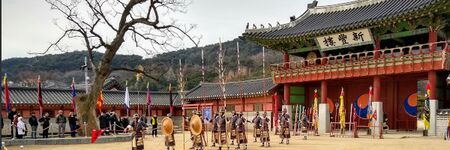Gyeonggi Korea: Difference between revisions
Created page with "{{Infobox municipality |municipality= Province |established = 1981 |image = |image_caption = |image_seal = Emblem of Gyeonggi Province (2021).svg |area = 10184 sq.km |elevatio..." |
No edit summary |
||
| Line 1: | Line 1: | ||
{{Infobox municipality | {{Infobox municipality | ||
|image=Hwaseong Fortress Suwon Gyeonggi.jpg | |||
|image_caption=Hwaseong Fortress Suwon Gyeonggi | |||
|image = | |image_seal=Emblem of Gyeonggi Province (2021).svg | ||
|image_caption = | |established=1981 | ||
|image_seal = Emblem of Gyeonggi Province (2021).svg | |area=10184 sq.km | ||
|area = 10184 sq.km | |elevation=5,453 ft | ||
|elevation = 5,453 ft | |population=13,413,459 | ||
|population = 13,413,459 | |website=http://english.gg.go.kr | ||
|website = http://english.gg.go.kr | |timezone=UTC+9 | ||
|timezone = UTC+9 | |description=Gyeonggi Province is the most populous province in South Korea. Its name, Gyeonggi, means "the area surrounding the capital". Thus Gyeonggi-do can be translated as "province surrounding Seoul". Seoul, the nation's largest city and capital, is in the heart of the province but has been separately administered as a provincial-level special city since 1946. Incheon, the nation's third-largest city, is on the coast of the province and has been similarly administered as a provincial-level metropolitan city since 1981. The three jurisdictions are collectively referred to as Sudogwon and cover 11,730 km2 (4,530 sq mi), with a combined population of 25.5 million—amounting to over half of the entire population of South Korea. | ||
|description= | |||
Gyeonggi Province is the most populous province in South Korea. Its name, Gyeonggi, means "the area surrounding the capital". Thus Gyeonggi-do can be translated as "province surrounding Seoul". Seoul, the nation's largest city and capital, is in the heart of the province but has been separately administered as a provincial-level special city since 1946. Incheon, the nation's third-largest city, is on the coast of the province and has been similarly administered as a provincial-level metropolitan city since 1981. The three jurisdictions are collectively referred to as Sudogwon and cover 11,730 km2 (4,530 sq mi), with a combined population of 25.5 million—amounting to over half of the entire population of South Korea. | |||
}} | }} | ||
Revision as of 06:32, March 26, 2022
- Members
Gyeonggi Province is the most populous province in South Korea. Its name, Gyeonggi, means "the area surrounding the capital". Thus Gyeonggi-do can be translated as "province surrounding Seoul". Seoul, the nation's largest city and capital, is in the heart of the province but has been separately administered as a provincial-level special city since 1946. Incheon, the nation's third-largest city, is on the coast of the province and has been similarly administered as a provincial-level metropolitan city since 1981. The three jurisdictions are collectively referred to as Sudogwon and cover 11,730 km2 (4,530 sq mi), with a combined population of 25.5 million—amounting to over half of the entire population of South Korea.
Activities

|
GO-PS Gyeonggi Open Platform for SmartCity | |
| GO⋅PS is a smart city standard platform to utilize the element technology of the age of 4th Industrial Revolution as a means to solve urban problems.
The Gyeonggi Province of Korea, along with Gyeonggi Research Institute (GRI) and Gyeonggido Business and Science Accelerator (GBSA), is currently creating and operating an industry-academia-related consultative body to create a sustainable business model. GO⋅PS matches companies, research institutes, and academics according to the demand of public urban matters, and uses its technologies, research works, and consulting methods to create solutions for problems and have them collected on the platform. The GO・PS is currently comprised of three large departments namely, Smart Transport, Smart Energy, and Smart Healthcare. (It is planned to be expanded with more departments in the future) | ||

